Mathematical Indication of A Real Adam and Eve |
|


| Mathematical Indication of a A Real Adam & Eve |

|
Is it even mathematically possible to populate the earth, after the great flood, to current numbers starting with 2 people over 5000-6000 years as claimed in the Bible?

Yes, using mathematics at the level of junior high school, it is possible, because mathematically the population would grow exponentially. However, this is only true with naive mathematics. Proper mathematical calculations would have to make allowance for infant deaths, deaths from misadventure or disease, plagues and pandemics that obliterate entire populations, famines and wars.

Proper mathematical calculations would would also allow for adjustment at intervals when we have good estimates of the world’s population, and then extrapolate for a higher or lower rate of increase to the next check point rather than assuming a constant growth rate.

|

|
|

 
Article - 1 from Creation.com
Biblical Human Population Growth Model
https://creation.com/biblical-human-population-growth-model
by Robert Carter and Chris Hardy -21 Pages -

|
The Bible presents several historical scenarios in which the human population grew from very small numbers. These include the initial populating of the world starting with Adam and Eve and the repopulating of the earth from three founding couples after Noah’s Flood. There were also multiple small-scale duplications of these events within the many post-Babel populations, including the growth of the Hebrew nation from Jacob and his twelve sons.

Most modern commentators on the subject of biblical demographics have assumed a smooth increase in the population over time, but small populations do not tend to grow in an algebraic manner.

We wanted to analyze many different biblical scenarios, so we created a population modelling program in the C# programming language that could handle multiple variables like age of maturation, minimum child spacing, and age of menopause, as well as probabilities like polygamy, twinning rates, and a variable risk of death according to age.

We were able to demonstrate that the current world population and the size of the Exodus population are easy to account for under most parameter settings. The size of the antediluvian and Babel populations, however, remain unknown.

Multiple authors have written briefly about mathematical feasibility of the demographic claims in the Bible. Most have concluded there is no biblical paradox but most have only cursorily dealt with the issues involved. Despite occasional claims from skeptics,1 it is entirely possible to obtain significant numbers of people in short amounts of time. 2

This includes reaching a world population of over 7 billion people in only ~4,500 years since the Flood.3 Morris was the earliest reference we could find for someone who attempted an algebraic solution.4

He attempted to account for generation time, family size, and longevity in his calculations but this was prior to the invention of the personal computer and he simply could not track as many variables as is possible today. Later commentators have tended to use a simple algebraic approach (see the exponential growth formula below) to answer these questions as well.
|
 
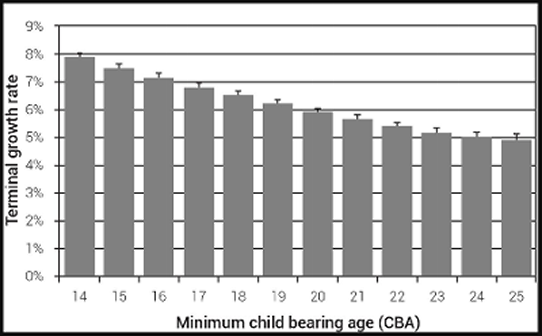

| Figure 1. Terminal growth rate vs minimum CBA (childbearing ages) for a population starting with three founding couples and allowed to reproduce to at least 10,000 individuals. Minimum child spacing was set to 1 year. Maximum CBA was set to 45. Results are the average of 1,000 model runs for each parameter setting. Error bars are 1 S.D. Click for larger view. |


|
Population growth depends on a combination of birth rate and death rate and is affected by the carrying capacity of the environment. Humans, unlike other species, have the ability and intelligence to grow beyond what would otherwise be the environmental carrying capacity, witnessed by the dramatic growth of the world population in recent decades.

While we do not know what environmental challenges the antediluvian and immediate post-diluvian populations faced, human populations have the ability to grow quite quickly. Based on numerous examples from recent history, we expect the early post-Creation and post-Flood generations would have experienced a rapid population increase, under a wide range of potential conditions, but what rate of growth is reasonable?

The standard exponential model of population growth is as follows:

N = N0e kt

where N = the population size at time t, N0 is the population size at time 0, and k = the growth rate. Importantly, this formula should only be applied to large populations. While it is true that the human population only needed to average a 0.464% growth rate (k) to go from 6 (N0) to 7 billion (N) people in the c. 4,500 years (t) since the Flood, the growth of small populations is stochastic by nature.

One reason for this is the fact that random births and deaths have a much greater effect in a population of, for example, 10 individuals than they do in a population of 10,000 individuals.

Another reason is the unpredictable availability of members of the opposite sex in very small populations. Consider a biblical model starting with Adam and Eve. The population size at 100 years could be drastically different if they had children in the order boy-girl-boy-girl-boy-girl versus a scenario where they had a series of boys (or a series of girls) in the early years. Thus, it is impossible to predict or accurately model the growth of small populations with the exponential growth formula.

Modern genetic data indicate the human population has exploded over the past several thousand years. 5 But that is only considering the size of the population. In fact, excess population has had a significant factor throughout much of world history. For example, various Greek colonies were founded across the Mediterranean and Black Sea regions by young people looking for space.

Likewise, the invasions of the Germanic tribes into Roman Europe in the waning years of that empire were driven in part by population expansion. And the Viking invasions across Europe several centuries later were propelled by that population’s ability to raise more children than the culture could provide space for. 6

Throughout recorded human history, the rate of population growth has often been great enough to put extreme pressure on land ownership and the control of resources, sometimes leading to mass migration, and often sparking wars.
|

 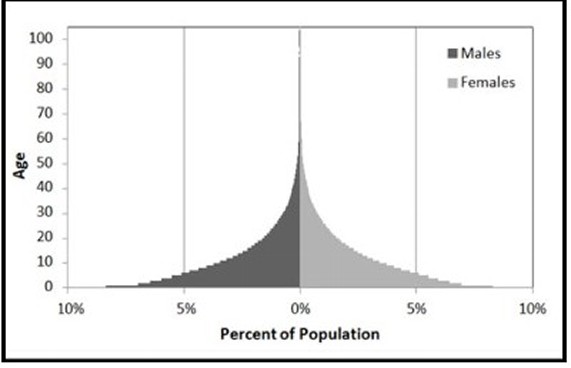

| Figure 2. Population structure with a minimum CBA of 14, a maximum CBA of 45, and a minimum child spacing of 1 year (average of 1,000 model runs that ended when n >= 10,000 individuals; error bars omitted). Click for larger view. |

|
One might ask, “Given the high reproductive capacity of people, why has the population grown so slowly?” The answer is probably that most people ever born probably died of warfare (often fuelled by population excess), starvation (due to war or weather), or disease before they reached their full reproductive potential. These factors are very much dependent on population density, however, and so should have less impact when a population is small and growing.

Biblically, the entire human race descends from just two people, Adam and Eve. Growing to unknown numbers over the first one and a half millennia, the population then went through an extreme but short bottleneck when only eight people survived Noah’s Flood. From the three sons of Noah (and their three wives), the population grew again to unknown numbers before being subdivided at the Tower of Babel, whereupon each of the resulting subpopulations followed an independent, and complex, growth trajectory.

Those three demographic expansion events need to be addressed mathematically to see if they comport to reality. An additional population expansion mentioned in the Bible is that of the Israelites. Only a few centuries after Jacob, his twelve sons, and their children moved to Egypt, 7 several million Hebrews left at the Exodus. Some argue for a ‘short’ sojourn of 215 years, while others argue for a ‘long’ sojourn of 430 years. This is a long-standing textual debate that also influences the date of creation. 8

The large size of the Israelite population at the Exodus has been used as a critique of the short sojourn hypothesis.9 Is this a valid critique? Can 12 adult couples produce several million people in just 215 years?

We understand that it is possible to get a large population in a short amount of time, but do all scenarios lead to such population growth? And how likely is it that the sparse biblical data actually match the historical record? We wanted to explore the demographic possibilities within each of these major biblical scenarios. To that end, we wrote a computer program that tracked as many factors as possible, including age of maturation, minimum child spacing, age of menopause, rates of polygamy, twinning rates, and a death probability based on actuarial tables.

We also wanted our model to be flexible enough to examine post-Creation, post-Flood, and both the long and short Egyptian sojourn scenarios. Historically, most population models use discrete cohorts, where each generation is treated as a discrete set and removed from the population model after reproducing.

This is sufficient for species with an annual life-death cycle, and works well enough for long-lived species with large population sizes, but it is not sufficient for the biblical scenarios we wanted to model. Instead, we tracked each individual separately and used probability distributions to determine their survival, marriage, and number of children.
|

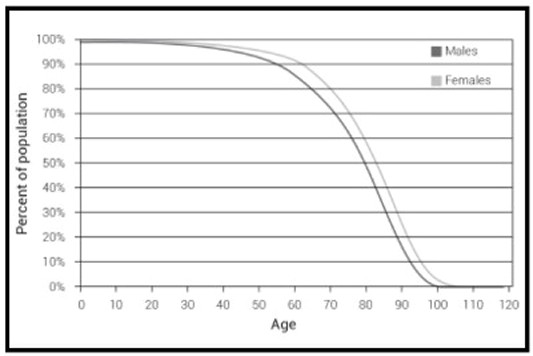

| Figure 3. Percent survivorship curve with a minimum CBA of 14 and a minimum child spacing of 1 year (average of 1,000 model runs that ended when n >= 10,000 individuals; error bars omitted). These data closely parallel the 2009 US actuarial tables that were used to estimate death rates at each age. Click for larger view. |

|
This allows for more realistic scenarios where members of different generations may mate.

Methods

We constructed a population tracking program in the C# programming language that can be used for a wide range of scenarios, including both large and small populations (up to the limits of available computer memory).10 For each scenario modelled, we set minimum childbearing ages (CBA) for females and males. This was the age at which children were entered into the marriage pool. We also set a maximum CBA for females.

We set the probability of a man getting married after passing the minimum CBA at 50% per year (6.7% per 1/10 year) if at least one lady was available. Once married, we assigned an initial annual pregnancy probability of 0.88. Children were born to each married couple with a minimum child spacing until the female reached the maximum childbearing age.

In order to approximate the risk of death, we incorporated the 2009 US actuarial tables11 into our model. This should be sufficient for asking how the modern human population could grow from three founding couples but we modified the curve in some model runs to better reflect the biblical data. For example, since the modern life expectancy of 75-80 years is approximately 1/12th the typical lifespan of 900 years before the Flood, we multiplied the age for death probabilities at each stage by 12 while modelling the antediluvian population.

The Maximum Age parameter sets the age at which the probability of dying that year reaches 1. Due to the exponentially increasing probability of death as age increases, only a tiny fraction of the population came to within 5% of the set maximum in any model run, as with real human populations. The actuarial table we used for our model (with a maximum age of 120) is based on modern populations, in which typically the oldest person known to be alive anywhere on earth is 114 or 115.

Although people in ancient populations probably suffered more early death due to disease and injury, while the elderly who avoided those risks lived longer than modern humans (at least through the Exodus), we are assuming the probability of death curve was similar then to now. In all post-Flood models reported here, we set the maximum age to 120, unless otherwise specified.

On top of the standard mortality tables, we added an extra factor to account for an increased risk of maternal mortality prior to the advent of modern medicine. Since childbirth has historically been the greatest mortality risk for women of childbearing age, we allowed a set risk of maternal mortality for each birth (double for twins), and we could modify the value as needed.

We assumed that the child also died if the mother died. This parameter has some overlap with both the minimum child spacing setting and the actuarial tables, but it allowed us increased flexibility to explore various scenarios.

Since we are dealing with ancient societies, we included the ability to model the effects of polygamy (more specifically, polygyny). There exist quite a large number of possibilities, so we settled on what seemed like a reasonable scenario and built flexibility into the program so we could explore alternate scenarios if necessary.

When the most generic model of polygamy was enabled, 1% of men with one wife were allowed first pick of the available females in the population. Men with two or more wives had a 5% probability of adding more. We set the maximum number of wives to 5. The remaining females were allowed to marry the remaining males at random. As always, any unmarried individuals were held over for the next round. Females who passed the maximum CBA while available were moved to the “widows” list.

When individuals were born into the population, they were assigned a birth date in tenths of years.12 This was done as a compromise. Annual increments led to stochastic outputs or strong ‘cohort’ effects where multiple children were reaching maturation and marrying at the same time, creating distinct pulses of population growth through childbirth, especially in the early years of population growth. On the other hand, dividing up years into 365 increments was computational overkill.
|
 
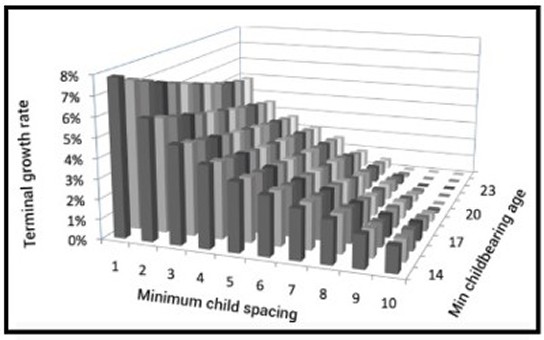
| Figure 4.Terminal growth rate vs minimum child spacing and minimum CBA. Results are for 1,000 model runs at each parameter setting (error bars omitted). Each run was terminated when the population size exceeded 10,000 individuals and the growth rates were calculated from the final order of magnitude change in population size (approximately the final 20% of the data). In almost all situations, the calculated growth rate was greater than the 0.464% required to go from the three post-Flood founding couples to the current world population of 7 billion people, but note that it was entirely possible for the population to go extinct under certain parameter settings. Click for larger view. |
 
|
Model assumptions

Even though we attempted to be as comprehensive as possible, there were several areas where we simply had to make assumptions. For example, we assume a rate of twinning of 1 in 89 births. This ratio changes over time and across cultures13 but since it is less than 2% of all births, it should have but a small effect on population growth.

Likewise, there is no available data for ancient maternal mortality when carrying twins, and ancient mortality rates should be higher than today, so we simply doubled the set maternal mortality rate for twins. We did not even consider triplets, for they are several orders of magnitude more rare and the maternal death rates in these cases were extreme for times more than 100 years ago.

We allowed for remarriage after the death of a spouse, but only as long as the living partner was below the CBA cutoff. Even though males could theoretically father children if they were above their CBA, we simplified things by not allowing them to remarry if older than that. Once married, couples stayed married until death.

See table 1 for the adjustable parameter list.

Results

Model validation— Figures 1, 2 and 3 show summary results of a simple model of population growth. Minimum child spacing was set to 1 year. Minimum CBA ranged between 14 and 25. Maximum CBA was set to 45. Maximum age was set to 120, but this parameter had little effect on the final results because very few people lived to anywhere near the maximum age.

Results are the average of 1,000 model runs for each setting of CBA. Figure 1 shows the terminal growth rates (the slope of the line from each graph of population size versus time), calculated from the final order of magnitude of population growth (approximately the final 20%) of each model run.

Figure 2 shows the population structure of a model run with minimum CBA set to 14. The thin, tall peak in the chart is due to a high maximum potential age (a very few people simply lived a long time). The shape of the distribution is similar to that of a ‘young’ population like that of modern Nigeria. 14

When minimum CBA increases, there are proportionally fewer young individuals in the population and the pyramid has a narrower base (data not shown). When minimum CBA is set to very high values, we noticed a ‘cohort’ effect, where the delay in reproduction produced several waves of population growth as multiple individuals reach reproductive age simultaneously.15

This is similar to the ‘baby boom’ that occurred in Western countries after World War II. These waves were due to the fact that we started with N couples already at reproductive age but with no children.

All modelled populations took several decades to settle down into a regular, algebraic growth phase. Most of the variability occurred when the population size was less than 100 individuals and almost all variability was evened out by the time 1,000 individuals were alive.
|

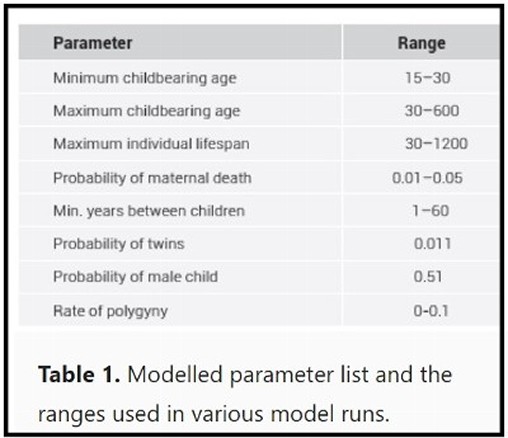

| Figure 3 shows the percent survivorship curve for a modelled population with minimum CBA set to 14. |
 
|
From the Flood to the modern population

Figure 4 displays the results of a multi-parameter model run (minimum child spacing versus minimum CBA), using modern (USA 2009) actuarial data and a post-Flood-like scenario with three founding couples. We allowed the minimum child spacing to range from 1 to 10 years and the minimum childbearing age to range from 14 to 25 years.

In almost all scenarios where the population did not go extinct, the critical level of 0.464% (the rate required by the exponential model of population growth to reach seven billion people in 4,500 years from three founding couples, see above) increase per year was reached. In other words, it is trivial to obtain the current world population from three founding couples in four and a half millennia.

Impact of polygamy

In Figure 5 we show the effect of polygamy (polygyny). A small percentage of men were allowed up to a maximum of five wives (details in Methods). On average, most model runs experienced a boost of approximately 4% over baseline (i.e. they were growing at 104% the rate of a non-polygamous model with the same parameter settings).

Near the edge of population survivability, polygyny enabled some populations to experience more growth, on average, due to the fact that unwed women were more rare. In other model runs (data not shown) we increased the polygamy rate up to 10%. At these extreme values, there was a much stronger effect at the margins of survivability, but this levelled off at higher growth rates. For most parameter settings, the net effect was not more than an additional 1% increase over baseline.
|



| Figure 5. Effects of polygamy (polygyny) compared to the baseline (figure 4). Results are the average of 1,000 model runs at each parameter setting (error bars omitted). The impact of polygamy was noticeable but not very strong. Most model runs experienced a boost of approximately 4% over baseline (i.e. 104% the growth rate of a non-polygamous population with the same parameter settings). Near the edge of population survivability (i.e. with high CBA and large gaps between children) polygyny enabled some populations to experience more growth, on average, due to the fact that unwed women were more rare. Click for larger view. |

|
The impact of very old people having children

By varying the maximum age of childbearing, it is possible to illustrate the potential impact of very old women having children. Figure 6 shows the terminal growth rates of multiple model runs. Each has a minimum CBA of 20. Maximum CBA varied from 40 to 100 in 5-year increments and the minimum spacing between children varied between 1, 2, or 3 years.

Children born into smaller populations have a greater percentage impact on the future population than children born into larger populations. Therefore, the impact of increasing the years of childbearing has a diminishing effect. Here, children born when a woman was 100 years old entered a population 59, 27, and 17 times larger, respectively, for the three values of minimum child spacing, than a child born when that same woman was 40.

From the Flood to the Tower of Babel

The date of the Tower of Babel event is unknown. From context, it appears the timing has something to do with a man named Peleg, whose name means ‘division’ (Gen 10:25). 16 He was born c. 101 years after the Flood and lived until c. 340 years after the Flood (Gen 11). 17

If the division of people occurred only 100 years after the Flood, there would not be many people in the world. However, the data behind the growth rates calculated in figure 4 indicate that under some scenarios it is possible to obtain a population size greater than 1,000 individuals in that much time.

This occurred at all settings of minimum CBA with a minimum child spacing of 1 year, or with small minimum CBA and a minimum child spacing of 2 or 3 years. It is also possible to arrive at over 10,000 individuals with a minimum child spacing of 1 year and a minimum CBA ≤ 17, and up to 40,000 individuals with a minimum CBA of 14, although these are not likely scenarios.

After 340 years, it is trivial to have 1,000 individuals in the population and most parameter settings produce population sizes many orders of magnitude greater than that. How many people were in existence when the population was divided? Sadly, one cannot determine the number from numerical analyses like these.

The Sojourn

According to Exodus 12:37-38, there were 600,000 Hebrew men in the Exodus population. Numbers 1:46 gives a more precise 603,550 men aged 20 and up. There are several ways to estimate the Exodus population size. If one assumes an equal number of females and more children than adults at the Exodus, a figure of 2.7 million is a good approximation. Starting with 12 founding couples, it was possible to reach 2.7 million people within the 215-year ‘short’ sojourn model, but only under certain, favourable parameter settings (figure 7).

In the 430-year ‘long’ sojourn model, reaching a population size of 2.7 million was trivial (figure 8). Of course, the final population sizes we are reporting here are unrealistic. Environmental restraints would take over long before these extreme population sizes were reached.

The antediluvian population size

We modelled various scenarios that started with a single founding couple. As before, it was simple to obtain significant numbers in a short amount of time. However, we know very little about the age of maturation (minimum CBA), minimum or average child spacing, etc., of antediluvian women.

Therefore, there are too many unknown variables and there is no way to estimate the antediluvian population size. It could have been in the billions. Or it could have been a few thousand. We cannot know.
|

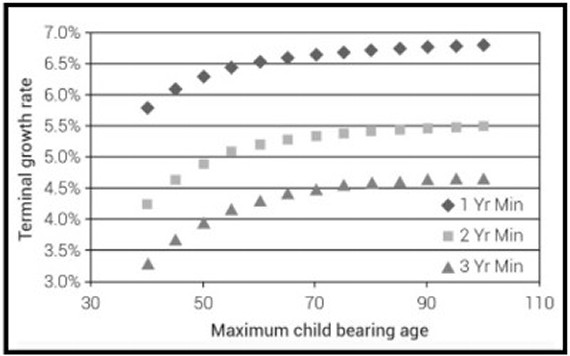

| Figure 6.Terminal growth rate vs maximum childbearing age for three levels of minimum child spacing. In all cases, the minimum CBA was set to 20, meaning the span of childbearing ranged from 20 to X years. Increasing the range of childbearing by allowing older women to have children has a diminishing effect on the population growth rate, as expected. Therefore, if the biblical Patriarchs (and their wives) lived to very old age, and had children at a great age, this would have little impact on the growth rate of the population. Click for larger view. |

|
Discussion

Using realistic demographic parameters, all modelled populations experienced rapid growth, on average. It was entirely possible to drive a population to extinction, however. As the average number of children per female approached the ‘replacement value’, more simulation samples resulted in extinction. When the minimum CBA and child spacing was such that women could have more than two children only by bearing twins, all samples went extinct.

The exact replacement value depends on many factors. Essentially, it is the number of children each female must have in order to guarantee that at least one female child reaches adulthood, on average. The number is often cited as ‘2.1’, but it is less than that in Western cultures and often much greater than that in developing countries.18 We included parameter settings that led to extinction in figures 4 and 5 to illustrate this.

There are two main factors that influence population growth the most: minimum CBA and minimum child spacing. This makes sense in that a population will grow most quickly when people marry young and have children close together. This also means, however, that the maximum CBA is far less relevant. Furthermore, since the people who reproduce earliest will have a higher percent representation in the future population, genetics should be driving all populations towards faster reproduction, by default.

Early maturation is thus a mathematical certainty, given a population with individuals that have a range of maturation ages. This alone could explain the population-wide drop-off in lifespan after the Flood. While it is true that individual mutation count should increase over time, contributing to a decline in lifespan, 19 it is also true that the ones who reproduce the fastest will outnumber those who do not. In the end, maximum lifespan does not matter.

This comes into sharp focus when considering modern cultures. For many reasons, people in wealthier ‘First World’ nations are tending to have fewer children, farther apart, and with a delayed start of childbearing. And, while China and India have huge populations, their growth is levelling off, while the population of Africa is still increasing rapidly. Life expectancy is generally higher in the slowest-growing populations.

It is not necessary to model the great ages of the biblical Patriarchs, or the fact that their ages decreased over time, because children born to these people late in life are almost irrelevant as far as their impact on future population growth is concerned. The future impact on the population size caused by the birth of any specific individual is simply the inverse of the population size at that time.

In fact, the relative individual impact on the future population size of any two people is simply the ratio of inverse population sizes when each person was born, which can be reduced to a simple ratio of the relative times when they were born:
|

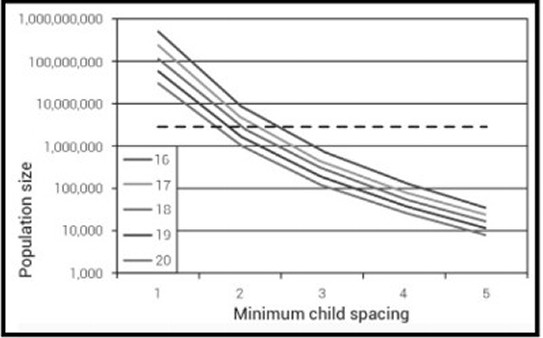

|
Figure 7. Population size vs minimum child spacing for five settings of minimum CBA (legend) in the short sojourn model. Starting with 12 founding couples, it was possible to reach the required estimate of 2.7 million Hebrews in 215 years (any place where the graphed lines are higher than the 2.7 million cutoff line), but only under certain favourable parameter settings (minimum child spacing had to be < 3 in all cases and < 2 in some cases). Note that environmental limitations would have prevented the population from reaching the largest projected sizes. Click for larger view.
|

(1/N0e kt1) / (1/N0e kt2) = t2/t1

|
The only caveat is that people who lived a long time may not have matured as young as modern people, so the minimum CBA might come into play to a greater degree than we illustrate here. Yet, the average generation span for the first seven generations born after the Flood is 31.4 years, and there is no reason to suspect these are all oldest children.20 Interestingly, the modern average human generation time is approximately 30 years. 21

This brings up another interesting point; kingship has historically been conferred on the eldest sons. Thus, one might expect a long line of kings to experience more generations on average per century than the rest of the population.

Thus, when Jacob met Pharaoh, he asked him how old he was, as if he was surprised to have met such an old man (Gen 47:8). Jacob was but 12 generations removed from Noah and was the grandson of Abraham, who had met another Pharaoh approximately 200 years earlier. How many generations after the Flood was the Pharaoh of Jacob’s day, and how many generations was he removed from the Pharaoh who knew Abraham two centuries prior?

The subject of how many generations removed were the modelled people from the starting ancestors is fascinating.

We included this calculation for the sake of curiosity. In each run, there were always people with very long lines going back to the founding couple (essentially equal to the length of run/minimum CBA) and at the same time people with very short lines in their family tree (due to the fact that very old men could still father children with younger wives). There are modern analogues to the Abraham-Pharaoh scenario, 22 so this should really be no surprise.

Concerning the Egyptian sojourn, we started with 12 couples with no children, but Gen 46:27 indicates that Jacob’s sons had already started reproducing before he moved to Egypt. In other words, the clock started before they arrived in Egypt and the 215-year sojourn is a minimum figure. Adding more individuals to the starting population size makes it easier to arrive at the required Exodus population size then we report here.

Also, Jacob brought household servants with him to Egypt (Gen 12:16, Gen 14:14, and cf Gen 46:1 “all that he had”), who might have occasionally married into the family. This is especially true of the women, but the male servants were also circumcised (Gen 17:13), meaning they were at least tangentially part of the Covenant.

Could long-standing, multigenerational, faithful, God-fearing, male family servants have married into the family as time progressed? This is likely, especially since many of them would eventually have Jacob as an ancestor, for obvious reasons.
|

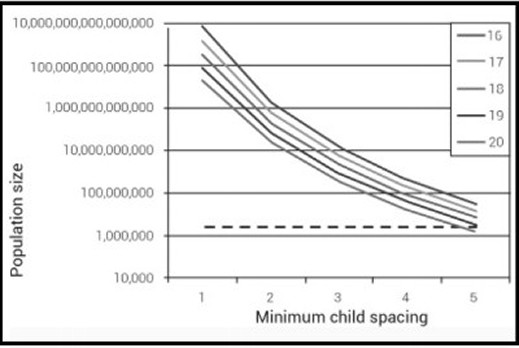

| Figure 8. Population size vs minimum child spacing for five settings of minimum CBA (legend) in the long sojourn model. Starting with 12 founding couples, it was possible to reach the required estimate of 2.7 million Hebrews in 430 years under almost all parameter settings, but note that environmental limitations would have prevented the population from reaching the majority of these projected sizes. Click for larger view. |

|
In conclusion, it is relatively easy to explain the modern world population, starting with the six Flood survivors, in c. 4,500 years. The number of people alive at the Tower of Babel event is more difficult to determine, but could easily have been in the thousands, or even tens of thousands, under certain conditions.

The long/short sojourn debate cannot be answered with demographic data, but there is no reason to reject the short sojourn from numerical data alone. And, it is impossible to estimate the number of people alive at the Flood, for we simply do not have the necessary demographic data.
|


|
References and notes
1. E.g., Repopulation after the Flood, talkorigins.org. Return to text.
2. Morris, H., How Populations Grow, undated; icr.org. Return to text.
3. Batten, D., Where are all the people?, Creation 23(3):52–55, 2001; creation.com/people. Return to text.
4. Morris, H.M., World population and Bible chronology, CRS Q 3(3):7–10, 1966. Return to text.
5. Keinan, A. and Clark, A.G., Recent explosive human population growth has resulted in an excess of rare genetic variants, Science 336 (6082): 740–743, 2012 | doi: 10.1126/science.1217283. Return to text.
6. Cunliffe, B., Europe Between the Oceans: 9000 BC–AD 1000, Yale UniversityPress, 2008. Return to text.
7. Carter, R.W., Inbreeding and the origin of races, J. Creation 27(3):8–10, 2013; creation.com/terah. Return to text.
8. Hardy, C. and Carter, R., The biblical minimum and maximum age of the earth, J. Creation 28(2):89–96, 2014; creation.com/biblical-earth-age. Return to text.
9. E.g. Minge, B., ‘Short’ sojourn comes up short, J. Creation 21(3):62–64, 2007. Return to text.
10. Copies available upon request. Send an email to us@creation.info. Return to text.
11. Actuarial tables courtesy of the US Social Security Administration: ssa.gov. Return to text.
12. See also the discussion of ‘date slippage’ in Hardy and Carter, ref. 8. Return to text.
13. Pison, G. and D’Addato, A.V., Frequency of Twin Births in Developed Countries, Twin Res Hum Genet. 9(2):250–259, 2006 | PMID: 16611495. Return to text.
14. Population Pyramids of the World from 1950 to 2100, Nigera 2010; populationpyramid.net. Return to text.
15. These can be reproduced easily by interested parties using the original program. Return to text.
16. Sarfati, J., ‘In Peleg’s days, the earth was divided’: What does this mean?, 3 Nov 2007; creation.com/peleg2. Return to text.
17. For a discussion of the ambiguities associated with these dates, see Hardy and Carter, ref. 8. Return to text.
18. Espenshade, T.J., Guzman, J.C. and Westoff, C.F., The surprising global variation in replacement fertility, Popul Res Policy Rev 22(5):575–583, 2003 | doi: 10.1023/B:POPU.0000020882.29684.8e. Return to text.
19. Wieland, C., Decreased lifespans: Have we been looking in the right place?, J. Creation 8(2):138–141, 1994; creation.com/lifespan. Return to text.
20. Carter, R., How old was Cain when he killed Abel?, Creation 36(2):16–17, 2014; creation.com/cain-chronology. Return to text.
21. Langergraber, K.E., et al., Generation times in wild chimpanzees and gorillas suggest earlier divergence times in great ape and human evolution, PNAS 109(39): 15716–15721, 2012 | doi: 10.1073/pnas.1211740109. Return to text.
22. An example would be the two currently living grandchildren of John Tyler, who was born in 1790 when George Washington was President, and who was himself U.S. President 1841–1845; cf. wikipedia.org. Return to text.
|


|


Article - 2 From Creation.com
https://creation.com/population-growth-since-flood
How did we get so many people in such a short time? by Jonathan Sarfati Updagted 1 September 2013 - 2 Pages -
|
To work out how quickly a population can grow, it’s very important to understand exponential growth. Starting from eight people after the Flood, the population would have to double only 30 times to reach 8.6 billion. Now there is a well-known ‘Rule of 72’,1 which says divide 72 by the percentage growth rate to get the time required for doubling. E.g. if inflation is 8% p.a., then in 72/8 = 9 years, the cost of living will have doubled.

Starting from eight people after the Flood, the population would have to double only 30 times to reach 8.6 billion. Now there is a well-known ‘Rule of 72’, which says divide 72 by the percentage growth rate to get the time required for doubling.

So what is a realistic growth rate? The Encyclopaedia Britannica claims that by the time of Christ, the world’s population was about 300 million. It apparently didn’t increase much up to AD 1000. It was up and down in the Middle Ages because of plagues etc.

But may have reached 800 million by the beginning of the Industrial Revolution in 1750—an average growth rate of 0.13% in the 750 years from 1000–1750. By 1800, it was one billion while the second billion was reached by 1930—an average growth rate of 0.53% p.a.

This period of population growth cannot be due to improved medicine, because antibiotics and vaccination campaigns did not impact till after WWII. From 1930 to 1960, when the population reached three billion, the growth rate was 1.36% p.a. By 1974, the fourth billion was reached, so the average growth rate was 2.1% from 1960 to 1974.

From 1974 to 1990, when the mark hit five billion, the growth rate had slowed to 1.4%. World population reached 6 billion in 1999 and 7 billion in 2011. The increase in population growth since WWII is due to fewer deaths in infancy and through disease.

If the average growth rate were a mere 0.4%, then the doubling time would be 180 years. Then after only 30 doublings or 5400 years, the population could have reached over eight billion.

If you want something more rigorous, there are standard mathematical formulæ that can be used to calculate population growth. They must include birth and death rates as well as generation time. The simplest formula involves just a constant growth rate:

N = N0 (1 + g/100)t

where N is the population, N0 is the initial population, g is the percentage growth rate per year, and t is the time in years. Applying this formula to the population of eight surviving the Flood, and assuming a constant growth rate of 0.45% p.a. and 4500 years:

N = 8 (1.0045)4500 = 4.8 billion people.

Of course, the population growth hasn’t been constant, and would have been very fast just after the Flood. Thus this formula by itself cannot be used to prove a young earth. However, if the world’s population had been in the millions for 100,000 years, then where are all their bodies? (See also 101 evidences for a young age of the earth and the universe, section ‘Human history is consistent with a young age of the earth’.)

First published: 13 April 1998
Re-featured on homepage: 2 October 2013

References and notes:

More precisely, the formula is: doubling time = 100 ln2/g, where ln2 is the natural logarithm of 2 (0.693) and g the percentage growth rate. So it would be slightly more precise to use a ‘Rule of 69’, but 72 is chosen because more numbers divide evenly into it, and it is good enough for an approximate rule of thumb.

(The rule is also handy for calculating the doubling time of a debt or investment, using the percentage interest rate instead. This is a little more complex because the population case is analogous to continuously compounded interest, while in finance the interest might be compounded annually. But here the precise number is closer to 72 than in the population case. See The Rule of 72—Why it Works.)

Related Articles:

 Where are all the people? Where are all the people?
https://creation.com/where-are-all-the-people

 Where have all the people gone ? Where have all the people gone ?
https://creation.com/human-population-growth

 Focus: Interesting question Focus: Interesting question
https://creation.com/news-of-interest-about-creation-and-evolution

 Age of the earth Age of the earth
https://creation.com/age-of-the-earth

 Modelling biblical human population growth Modelling biblical human population growth
https://creation.com/biblical-human-population-growth-model
 History Questions and Answers History Questions and Answers
https://creation.com/history-questions-and-answers

 Anthropology and Apemen Questions and Answers Anthropology and Apemen Questions and Answers
https://creation.com/anthropology-and-apemen-questions-and-answers
- Adam, Eve and Noah vs Modern Genetics
https://creation.com/noah-and-genetics

|
|
|



|

Article - 3 From Creation.com
https://creation.com/noah-and-genetics
Adam, Eve and Noah vs Modern Genetics
by Dr Robert W. Carter

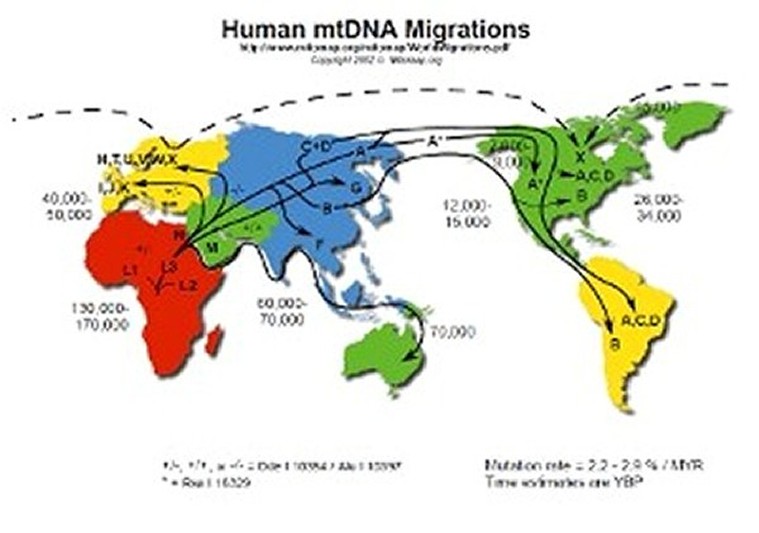

| The evolutionary map of world migrations is startlingly close to the biblical account of a single dispersal of people from Babel. The evolutionary “Out of Africa” theory tells us there was a single dispersal of people, centered near and travelling through the Middle East, with three main mitochondrial lineages, with people traveling in small groups into previously uninhabited territory, and that all of this occurred in the recent past. Every item in that list is something directly predicted by the Tower of Babel account in the Bible. (Image www.mitomap.org). |

|
It comes as a surprise to most people to hear that there is abundant evidence that the entire human race came from two people just a few thousand years ago (Adam and Eve), that there was a serious population crash (bottleneck) in the recent past (at the time of the Flood), and that there was a single dispersal of people across the world after that (the Tower of Babel). 1

It surprises them even more to learn that much of this evidence comes from evolutionary scientists. In fact, an abundant testimony to biblical history has been uncovered by modern geneticists. It is there for anyone to see, if they know where to look!

For our purposes, the most important places to look are in the Y chromosome (which is only found in males and which is passed on directly from father to son) and in the mitochondrial DNA (a small loop of DNA that we nearly always inherit from our mothers only; males do not pass it on to their children). These two pieces of DNA record some startling facts about our past.

Over the last decade, a vast amount of information has been collected that allows us to answer questions that we could not even consider earlier. The tools of modern genetics allow us to specifically ask questions about history, for our genes carry a record that reflects where we came from and how we got to where we are. The tools at our disposal are powerful.

Creation and genetics

There are two brief passages in the Creation account we can use to draw some conclusions about human genetic history. Please note that we cannot use these verses for land animals (because we do not know how many of each kind were initially created) or any of the swimming critters (“with which the waters abounded”— Gen 1:21). These statements apply to people only:

“And the Lord God formed man out of the dust of the ground, and breathed into his nostrils the breath of life; and the man became a living being.” Gen 2:7

“And the Lord God caused a deep sleep to fall on Adam, and he slept; and he took one of his ribs, and closed up the flesh in its place. Then the rib which the Lord God had taken from the man he made into a woman, and He brought her to the man.” Gen 2:21–22

These simple statements have profound implications. They put a limit on the amount of diversity we should find in people living today. The Bible clearly says the human race started out with two people only. But how different were these two people? There is an intriguing possibility that Eve was a clone of Adam. The science of cloning involves taking DNA from an organism and using it to manufacture an almost perfect copy of the original.

Here, God is taking a piece of flesh, with cells, organelles, and, importantly, Adam’s DNA, and using it to manufacture a woman. Of course, she could not be a perfect clone, because she was a girl! But what if God had taken Adam’s genome and used it to manufacture Eve? All he would have had to do was to leave out Adam’s Y chromosome and double his X chromosome and, voilá, instant woman!

I do not know if Eve was genetically identical to Adam. The only reason I bring this up is because we have two possibilities in our biblical model of human genetic history: one original genome or two. Either result is still vastly different from the most popular evolutionary models, 2 but we need to discuss the range of possibilities that the Bible allows.

Your genome is like an encyclopedia (almost literally). And, like an encyclopedia, the genome is broken down into volumes, called chromosomes, but you have two copies of each volume (with the exception of the X and Y chromosomes; women have two Xs but men have one X and one Y). Imagine comparing two duplicate volumes side by side and finding that one word in a particular sentence is spelled differently in each volume (perhaps “color” vs “colour”).

Can you see that if Eve was a clone of Adam, there would have been, at most, two possible variants at any point in the genome? If Eve was not a clone, however, there would have been, at most, four possible variants at any point in the genome (because each of the original chromosomes came in four copies). This still allows for a lot of diversity overall, but it restricts the variation at any one spot to 2, 3, or 4 original readings.

Does this fit the evidence? Absolutely! Most variable places in the genome come in two versions and these versions are spread out across the world. There are some highly variable places that seem to contradict this, but most of these are due to mutations that occurred in the different subpopulations after Babel.

There are indications, however, that Eve may not have been a clone. The ABO blood group is a textbook example of a gene with more than two versions.3 There are three main versions of the blood type gene (A, B, and O). However, many, but not all, people with type O blood carry something that looks very much like a mutant A (the mutation prevents the manufacturing of the type A trait on the outside of cells). So here is a gene with more than two versions, but one of the main versions is clearly a mutation.

This is true for many other genes, although, as usual, there are exceptions. The important take home point is that essentially all of the genetic variation among people today could have been carried within two people, if you discount mutations that occurred after our dispersion across the globe. This is a surprise to many.

The Flood and Genetics

Like in the Creation story, there are only a few verses in the Flood account that help us with our model. But as seen before, these verses are profound. About 10 generations after Creation, a severe, short bottleneck occurred in the human population. From untold numbers of people, the entire world population was reduced to eight souls with only three reproducing couples.

“So Noah, with his sons, his wife, and his sons’ wives, went into the ark because of the waters of the flood.” -Gen 7:7

“Now the sons of Noah who went out of the ark were Shem, Ham, and Japheth… These three were the sons of Noah, and from these the whole earth was populated.” Gen 9:18–19

We can draw many important deductions from these statements. For instance, based on Genesis 7 and Genesis 9, how many Y chromosomes were on the Ark? The answer: one. Yes, there were four men, but Noah gave his Y chromosome to each of his sons. Unless there was a mutation (entirely possible), each of the sons carried the exact same Y chromosome. We do not know how much mutation occurred prior to the flood.

With the long life spans of the antediluvian patriarchs, it may be reasonable to assume little mutation had taken place, but all of Creation, including the human genome, had been cursed, so it may not be wise to conclude that there was no mutation prior to the Flood. The amount of mutation may be a moot point, however, for, if it occurred, the Flood should have wiped out most traces of it (all of it in the case of the Y chromosome).

How many mitochondrial DNA lineages were on the Ark? The answer: three. Yes, there were four women, but the Bible does not record Noah’s wife as having any children after the Flood (in this case, girl children).

And notice the claim in Genesis 9:19, “These three were the sons of Noah, and from these the whole earth was populated.”

This is a strong indication that Noah’s wife did not contribute anything else to the world’s population. With no prohibition against sibling marriage, yet,4 one or more of the daughters-in-law may have been her daughter, but this does not change the fact that, at first glance, we expect a maximum of three mitochondrial lineages in the current world population.

There is a chance that there will be less, if there was very little mutation before the Flood or if several of the daughters-in-law were closely related. At most, we do not expect more than four.

How many X chromosome lineages were on the Ark? That depends. If you count it all up, you get eight. If, by chance, Noah’s wife passed on the same X chromosome to each of her three sons (25% probability), then there were seven. If Noah had a daughter after the Flood (not expected, but possible), there could be as many as nine X chromosome lineages.

Either way, this is a considerable amount of genetic material. And since X chromosomes recombine (in females), we are potentially looking at a huge amount of genetic diversity within the X chromosomes of the world.

Does this fit the evidence? Absolutely! It turns out that Y chromosomes are similar worldwide. According to the evolutionists, no “ancient” (i.e., highly mutated or highly divergent) Y chromosomes have been found. 5

This serves as a bit of a puzzle to the evolutionist, and they have had to resort to calling for a higher “reproductive variance” among men than women, high rates of “gene conversion” in the Y chromosome, or perhaps a “selective sweep” that wiped out the other male lines.6 For the biblical model, it is a beautiful correlation and we can take it as is.

The evidence from mitochondrial DNA fits our model just as neatly as the Y chromosome data. As it turns out, there are three main mitochondrial DNA lineages found across the world. The evolutionists have labeled these lines “M”, “N”, and “R”, so we’ll refer to them by the same names. They would not say these came off the Ark.

They claim they were derived from older lines found in Africa, but this is based on a suite of assumptions ( I discussed these in detail in a recent article in the Journal of Creation 7). It also turns out that M, N, and R differ by only a few mutations. This gives us some indication of the amount of mutation that occurred in the generations prior to the Flood.

Let’s assume ten female generations from Eve to the ladies on the Ark. M and N are separated by about 8 mutations (a small fraction of the 16,500 letters in the mitochondrial genome). R is only 1 mutation away from N. This is an indication of the mutational load that occurred before the Flood. Given the assumption that mutations occur at equal rates in all lines, about four mutations separate M and N each from Eve (maybe four mutations in each line in ten generations).

But what about R? It is very similar to N. Were N and R sisters, or perhaps more closely related to each other than they were to M? We’ll never know, but it sure is fascinating to think about.

One more line of evidence crops up in the amount of genetic diversity that has been found within people worldwide. Essentially, much less has been found than most (i.e., evolutionists!) predicted. The general lack of diversity among people is the reason the Out of Africa model has humanity going through a disastrous, near-extinction bottleneck with only about 10,000 (and perhaps as few as 1,000)8 people surviving.

However, the reason for this lack of diversity is twofold. First, the human race started out with only two people. Second, the human race is not that old and has not accumulated a lot of mutations, despite the high mutation rate. Third, there actually was a bottleneck event, Noah’s Flood!

The Tower of Babel and genetics

The Tower of Babel has been a favorite bedtime story for generations. But is it more than a fairy tale? Could it be possible that there is evidence to back up this tale of rebellion and judgment? Like the Creation and Flood accounts, there are only a couple of verses that apply to our model of genetics. But, like the others, these verses are as profound as they are simple.

“Now the whole earth had one language and one speech.” Gen 11:1

“And they said, ‘Come, let us build ourselves a city, and a tower whose top is in the heavens; let us make a name for ourselves, lest we be scattered abroad over the face of the whole earth.’” Gen 11:4

It sounds like they were in a homogenous culture, but what do people in that situation do? Would you expect them to mix freely? Were language or cultural barriers present that would have prevented the sons of Shem from marrying the daughters of Japheth? Would the daughters of Ham be expected to marry freely with the sons of any of the three men?
Note in Gen 11:4 that they knew about the potential for spreading out and getting separated from one another and intentionally did the opposite! However, this was against the express command of God, who had ordered them to spread out (to populate the earth). So, He took matters into His own hands.

“’Come, let Us go down and confuse their language, that they may not understand one another’s speech.’ So the Lord scattered them abroad from there over the face of all the earth, and they ceased building the city.” Gen 11:7–8

There are tremendous implications that come from the Babel account. First it explains the amazing cultural connectivity of ancient peoples—like pyramid building, common flood legends, and ancient, non-Christian genealogies that link people back to biblical figures (e.g., many of the royal houses of pagan northern Europe go back to Japheth, the son of Noah 9).

The dramatic rise in world population over the past several decades is a well known fact. From a biblical perspective, the current human population easily fits into the standard model of population growth using very conservative parameters.10 In fact, starting with 6 people and doubling the population every 150 years more than accounts for the current human population (a growth rate of less than 0.5% per year!).

Population size would have increased quickly given the rate at which the post-Flood population reestablished agriculture, animal husbandry, industry and civilization. So we must ask the question, “Why are there so few people in the world today?” The answer is that the world is young and we have not been here many thousands of years.

When did the dispersion occur? Our best clue about the timing of the event comes from Genesis 10:25. In referencing the 5th generation descendent of Shem, a man named Peleg, it says, “in his days the earth was divided.” To what is this referring? Many people believe this is referring to a division of the landmasses (plate tectonics).

This may be true, but it would require a huge amount of geologic activity after the Flood, and this would have occurred in historical times with no record of the events. The interpretation I favor is that this passage is referring to the division of people at Babel. Just a few verses after the Peleg reference, the section is summed up with another reference to the division at Babel. This fits both the context and the science. In context, Peleg was closely associated with Babel.

How large was the population at the time? We would expect rapid population growth, but we cannot know exactly. There are 16 named sons born to the three brothers, Shem, Ham and Japheth. If we assume about the same number of daughters, Noah had on the order of 30 grandchildren. At that rate of growth, there would have been about 150 children in Salah’s generation, about 750 in Eber’s generation, and about 3,750 in Peleg’s generation.

Of course, these generations overlap, etc., so let’s say there were between 1,000 and 10,000 people alive at the time of Babel. This fits nicely with the available data. It is a high rate of growth, but wars and disease had yet to start taking their toll.

There is one more verse in this section that we need to discuss:

“These were the families of the sons of Noah, according to their generations, in their nations; and from these the nations were divided on the earth after the flood.” Gen 10:32

Do you see the implication in this simple verse? At Babel, God did not separate the nations according to language. He used language to separate them according to paternal (male) ancestry! This has monumental significance and is the key to understanding human genetic history. Paternal sorting would lead to specific Y chromosome lineages in different geographical locations.

Since males and females from the three main families should have been freely intermixing prior to this, it also leads to a mixing of the mitochondrial lines. It is as if God put all the people into a giant spreadsheet and hit a button called “Sort According to Father.” He then took that list and used it to divide up and separate the nations.

We already saw that Y chromosomes have little variation among them. We now add the fact that this little bit of variation is almost always geographically specific. That is, after the nations were separated according to Y chromosome, mutations occurred in the various lines. Since the lines were sent to specific geographical areas, the mutations are geographically specific. The current distribution of Y chromosome lines is a tremendous confirmation of the biblical model.

Mitochondrial DNA (mtDNA) adds another confirmation. We have already learned that there are three main lineages of mtDNA. We now add the fact that these three lineages are more or less randomly distributed across the world. Also, the various mutations within each of the three main families of mtDNA are geographically specific as well.11 In other words, as the three mixed mitochondrial lines were carried along with the Y chromosome dispersal, each line in each area began to pick up new mutations, just like we would predict.

After the Flood

The last remaining significant reference in the Bible that will help us build our model of human genetic history is called The Table of Nations. It is found in Genesis chapters 9 and 10. The Table of Nations is a record of the post-Babel tribes, who they descended from, and where they went. If the Bible is an accurate source of history, one might expect to be able to find a significant amount of evidence for the Table of Nations in genetic data.

The truth is not that simple, however, and it is important to keep several things in mind. First, the account was written by a person in the Middle East and from a Middle Eastern perspective.

It is incomplete in that there are huge sections of the world that are not discussed (sub-Saharan Africa, Northern Europe, Most of Asia, Australia, the Americas, and Oceania). It also reflects a snapshot in time. It was written after the dispersion began, but not necessarily before the dispersion was complete. Indeed, much has changed in the intervening years.

People groups have migrated, cultures have gone extinct, languages have changed, separate cultures have merged, etc. The history of man has been full of ebb and flow as people mixed or fought, resisted invasion or were conquered. The history of man since Babel is very complicated. Modern genetics can answer some of the big questions, but answers to many of the smaller details may elude us forever.

This is an important topic for the creation model. The world does not look at the Bible in a favorable light. In fact, it disparages it, sometimes with open hostility. Attacks are often centered on the claim that the Bible is not reliable on historical grounds, and if the history of the Bible is inaccurate, what about the theology?

Think about what Jesus told Nicodemus in John 3:12, “If I have told you earthly things and you do not believe, how will you believe if I tell you heavenly things?”

Many people today see no history in the Bible; therefore, the spiritual implications are meaningless to them. What would happen for evangelism if the history of the Bible turns out to be true after all?
Published: 11 May 2010
|

|
Notes and References
1. See Nelson, J.W., Genetics and Biblical demographic events, Journal of Creation [formerly TJ] 17(1):21–23, 2003; https://creation.com/genetics-and-biblical-demographic-events
2. The most common version of the Out of Africa Theory has people living in Africa (as Homo erectus) for about a million years. Several tens of thousands of years ago (the data varies from author to author), a sudden bottleneck event reduced the population to 10,000 people or less. Modern humans came out of this bottleneck, our population grew and diversified a little, and then we left Africa and colonized the rest of the world. Return to text.
3. Criswell D., ABO Blood and Human Origins, Acts & Facts 37 (2):10, 2008; ; as well as Sarfati, J., Blood types and their origin (Countering the Critics), Journal of Creation (then called CEN Technical Journal) 11(1):31–32, 1997. Return to text.
4. Prohibitions against marrying close relatives were first given in Lev. 18 and 20, about 2,500 years after Creation. Indeed, Abraham, Isaac and Jacob each married close relatives from their own family. Return to text.
5. Jobling, M.A., Tyler-Smith, C., The human Y chromosome: an evolutionary marker comes of age, Nature Reviews 4:598–612, 2003. Return to text.
6. Garrigan, D. and Hammer, M.F., Reconstructing human origins in the genomic era, Nature Reviews 7:669–680, 2006. Return to text.
7. Carter, R.W., The Neutral Model of evolution and recent African origins, Journal of Creation 23(1):70–77, 2009. Return to text.
8. Harpending, H.C., et al., The genetic structure of ancient populations, Current Anthropology 34:483, 1993. Return to text.
9. A five part series on this subject was printed in the Journal of Creation (then called CEN Technical Journal) in the early 1990s. See Cooper, W.R., The early history of man: Part 1. The table of nations. CEN Tech J 4:67–92, 1990. Return to text.
10. Batten, D., Where are all the people? Creation 23(3):52–55, 2001; creation.com/where-are-all-the-people. You can do your own simulation in a spreadsheet program using the formula N = Noekt, where No = the starting population size (6), k = growth rate per year (experiment with different rates and see what happens), and t = time (in years). Return to text.
Torroni, A., et al., Harvesting the fruit of the human mtDNA tree, TRENDS in Genetics 22(6):339–345, 2006. Return to text.
|
|


|




Article from 'Institue for Creation Research' from January 18, 2016
https://www.icr.org/article/population-study-standoff
CREATION SCIENCE UPDATE
| Man Was Recently & Miraculously Created in the Image of God |
Population Study Standoff By Brian Thomas, Ph.d. * | Janury 18, 2016

|
In 1975, ICR's founder and hydrological engineer Dr. Henry Morris made some interesting human population calculations. He demonstrated the feasibility of obtaining today's world population in only about 6,000 years.1 A new science study presents a very different version of human history—one in which the population grew very slowly for 200,000 years.2 Which should we believe?

At stake lies the truthfulness of biblical statements such as "These were the families of the sons of Noah, according to their generations, in their nations; and from these the nations were divided on the earth after the flood."3 Does the science in this new report debunk Dr. Morris' 40-year-old argument and, by extension, the Bible?

H. Jabran Zahid of the Smithsonian Astrophysical Observatory in Cambridge led a study that estimated ancient human population growth rates. Their results, published in the Proceedings of the National Academy of Sciences (PNAS), referred to 7,900 radiocarbon dates for burial sites in Wyoming and Colorado. Their formulas showed an annual growth rate of 0.041%, or a human population doubling every 1,700 or so years—far too slow to generate 7 billion people since the Flood about 4,300 years ago.

The study authors wrote, "A 0.04% rate of growth retrodicts a global human population of a few individuals 50,000 years ago."2 However, Dr. Henry Morris' article noted that the actual growth rate between 1650 AD and 1800 AD was about 0.33% per year.

The rate has spiked to around 2.0% worldwide in the last few centuries. Morris also noted that to obtain today's population from Adam and Eve in only 6,000 years suggests a growth rate of about 0.5% per year. Basically, the biblical and historical rates are both an order of magnitude (about ten times) faster than the one tied to secular radiocarbon age estimates.

Which estimate should be trusted and why?

One quote gives the answer. According to PNAS, "To measure the rate of growth for 6,000-13,000 cal BP [calibrated radiocarbon years before present],4 we fit a linear model to the logarithm of the SPD [summed probability distribution] as a function of time. The slope of the fit is the exponential rate of growth, which we report as an annual percentage."2 So, they fitted a model to time. Which timeline did they use? The evolutionary timeline, of course.

These researchers assumed that ancient radiocarbon age estimates from the Western United States generally correspond to actual calendar dates. In other words, they calculated growth rates by placing population size estimates on an extra-long timeline. This circular procedure ensures a very slow human population growth. No wonder it conflicts with biblical history.

In the same 1975 article Dr. Morris also wrote about secular scientists' speculations on ancient human population growth, saying, "Such guesses are useless, however, because they are based on a discredited model, that of human evolution."1 This new study confirms that secular ideas about ancient humans, masked under complicated scientific procedures, still lean on human evolution as a foundational assumption—four decades later.

The evolutionary idea that our population has grown so slowly that it would have taken over 50,000 years to reach today's numbers assumes the very age it asserts. It also flies in the face of historical population growth rates—two good reasons to reject it. If rejected, then the old argument for biblical history from human population growth rates still stands tall. 5
|

|
References
1. Morris, H. M. 1975. Evolution and the Population Problem. Acts & Facts. 4 (1).
2. Zahid, H. J., E. Robinson, and R. L. Kelly. Agriculture, population growth, and statistical analysis of the radiocarbon record. Proceedings of the National Academy of Sciences. Published online before print December 22, 2015, accessed December 28, 2015.
3. Genesis 10:32.
4. This calibration procedure adjusts raw radiocarbon dates to more closely match a mixture of science-based and evolution-based expectations, shown as a curve of radiocarbon age estimates on a timeline.
5. See also Thomas, B. Earth Hit the 7-Billion Mark Too Late. Creation Science Update. Posted on icr.org October 27, 2011, accessed December 29, 2015.
|


|


Article From Answers In Genesis
https://answersingenesis.org/adam-and-eve/could-2-people-populate-planet-7-billion-people/
Could 2 People Populate a Planet to 7 Billion People?
by Bodie Hodge on May 26, 2018 -- 2 Pages -

|
The Bible states that 2 people can populate a planet to 7 billion. No.

Where does the Bible say this? The Bible states that God commanded man to fill the earth (e.g., Genesis 1:28, 9:1, and 9:7)—which is far more than 7 billion!

But the claim that it is impossible to get seven billion descendants from two people is 100% wrong.

The Bible reveals that God, who is all-powerful, created two people initially (Genesis 1)—a man and woman (Genesis 1:26–27) called Adam and Eve (e.g., Genesis 2:19, 3:20; 1 Timothy 2:13). Adam was the first man (1 Corinthians 15:45), and Eve was the mother of all the living (Genesis 3:20).

Allow me to state the obvious to make some points: parents produce children. Those children grow up and produce children, and the process continues. Scientifically, we can test this: humans have more humans. Since mankind was commanded to be fruitful and multiply, childbearing and population growth is appropriate (Genesis 1:28).

Adam and Eve had many sons and daughters over the course of many years (Genesis 5:4), so, yes, originally brothers and sisters had to marry. That was admissible originally of necessity (and not a problem for genetic diseases that wouldn’t have existed yet so soon after the degenerate effects from sin and the curse), but God set up most familiar incest laws at the time of Moses (e.g., Leviticus 18), which was about 2,500 years after Adam and Eve.

So from the Christian position, it is no longer appropriate to marry close relatives. Some still defy God’s command against this (see: “A Mother in Oklahoma Married Her Son and Then Her Daughter, Who Just Pleaded Guilty to Incest, Officials Say” and “‘I’ve Married My Sister —Now We’re Having Our Second Baby’: Siblings Who Defied Law Plan to Start New Life Abroad.”).

Actually, we would have gotten to seven billion sooner if it hadn’t been for sin and the flood of judgment on that sin (Genesis 6–9). That event reset the population to eight people, where six of them (Shem, Ham, and Japheth’s families) were responsible for populating the earth (e.g., Genesis 6:10, 7:7, 8:16, 10:32). And population stats reveal that since the flood (about 4,350 years ago), we should be at about 6–7 billion people right now even at a conservative rate of doubling only every 150 years. Do the math.

Versus:

Consider the secular view that seven billion people on the earth came from an almost infinitely dense and hot matter that exploded and came from nothing, yet there is no criticism there?1 Let’s evaluate this. Do people come from people or do people come from inanimate material? We observe people coming from people, but people don’t come from rocks. One of these views is logical and clearly possible—one isn’t.

In a few thousand years, we expect only seven billion humans. But calculating how many humans there should be in tens of thousands of years doesn’t add up—or rather adds up quite a bit too much! I want to encourage you to trust God’s Word as the supreme authority for a starting point on the origin of people.
|

|
Footnotes:
Consider the implication here. There was nothing, not even time, reality, space/matter, or logic. Then suddenly, at a precise instant at the onset of time’s existence, there was time, reality, space/matter, and logic. So at one exact moment (the immaculate beginning) there was time and no time, reality and no reality, space/matter and no space/matter, logic and no logic in the same time and same instance, which violates the law of non-contradiction.
|


|


How The World Was Populated Before the Flood
From Never Thirsty
https://www.neverthirsty.org/bible-qa/qa-archives/question/how-was-the-world-populated/

|
Bible Question:

If there were only Adam, Eve, Cain and Abel in the beginning, how was the world populated?

Bible Answer:

The question we are concerned with is, “How was the world populated before the flood?”

How was the world populated before the flood?

First, Genesis 1:24-31 tells us that God created Adam and Eve on the sixth day. After He created them, He commanded them to have children and to populate the world.

And God blessed them; and God said to them, “Be fruitful and multiply, and fill the earth, and subdue it; and rule over the fish of the sea and over the birds of the sky, and over every living thing that moves on the earth.” Genesis 1:28 (NASB)

Adam and Eve were faithful to the Lord’s command and started populating the world. Cain and Abel were the first male children recorded in the Bible (Genesis 4:1-2). Seth came along later (Genesis 4:25).

It was common in the Bible to record the birth of only the sons and not the daughters. Also, it was common not to record all of the sons. It was rare that the daughters were named. For example, Genesis 5:4 states, then the days of Adam after he became the father of Seth were eight hundred years, and he had other sons and daughters. Genesis 5:4 (NASB)

But we do not know the names of the other sons and no names of any daughters. Nor are we told when they were born or how many. This example is typical of early birth records. Therefore, we do not know how many sons and daughters were born to Adam and Eve and to their descendants by the time of the flood.
|


Estimate of the world’s population before the flood


|
The world’s population continues to increase today. On May 13, 2023 it was estimated by the Worldometers.info that the world population was over 8.03 billion.[1] That is a great number of people but it is not a difficult number to reach. A conservative calculation reveals that the world’s population by the time of the flood would have easily exceeded 8.03 billion.

The calculation is a rough approximation since we do not know the birth rate exactly. The calculation requires several steps.

Step #1 – Determine the time from Adam and Eve to Noah’s Flood. The ancestral line of the early families is given in Genesis 5:1-32 and 11:10-32. From the genealogical listings, we can determine that Noah was born 1,056 years after the creation of Adam and Eve. Noah’s sons were born 500 years later and the flood occurred 100 years after Noah’s sons were born (Genesis 7:11). That means the flood occurred 1,656 years after the creation of Adam and Eve.

Step #2 – Ignore the initial years of population growth. Next, we are told in Genesis 4:16-24 that an initial population of males and females were living on the earth. Since Adam and Eve were the first parents, these humans were their offspring. Abel and Cain were named in scripture because they were involved in the first murder and sacrifice (Gen. 4:1-15).

Scripture reveals that Seth was born to Adam and Eve when they were 130 years old. Genesis 5:6 states that his first son was Enosh. He was born when Seth was 235 years old.

It is clear from Genesis that many children were being born who are not documented in scripture. If the first child of Adam and Eve was born when they were 30 years old, and additional children were being born every three years, the world would have had about 10 children on the earth when Adam and Eve were 60 years old.

It is entirely possible for children to have been conceived and born more frequently than every three years. Their first child would be 30 years old, using these assumptions. Let us assume that child A married a brother or sister, say child B or C, and then within three years after being married, this couple produced about 10 children by their 60th birthday or when Adam and Eve were 120 years old.

If we go back to either child B or C, who did not marry child A, and we assume that child married child D or E, then that child’s marriage would produce about 10 children when Adam and Eve were 124 – 128 years old.

If we keep the process going, it is easy to have 100 hundred children, at least, by the time Adam and Eve are 130 years of age, when Seth is born. Scripture typically does not record the birth of females or of all of the males. After 130 years, only 1,526 years remain for children to be born before the flood. The flood started 1,656 years after the creation. Now there is a population giving birth to children. So, that demonstrates the feasibility of rapid population growth.

Step #3 – Next, we must determine a birth rate for each couple. We will assume that each couple is giving birth to six children and then stops. This is unrealistic for parents who are living hundreds of years, but it will make our calculation simpler.

Step #4 – Determine a mathematical equation for population growth. To determine the population growth, we will assume that Enoch had offspring about every 10 years after he married. We will assume that each offspring does not have their first child until they are 117 years old and then they have six children spaced apart every 20 years for 117 years.

The number 117 years is the average age of the patriarchs when they had their first recorded child as given in Genesis 5:1-32 and 11:10-32. Most likely there were other children who were born earlier but not recorded. Yet, we will ignore this factor. For example, Seth is the only child mentioned in the generations before Adam and Eve (Genesis 5:1-5), but Cain and Abel were born earlier. However, they are not mentioned in these records.

Using these assumptions, Enoch would have had 6 children in 117 years. Now we assume that each of these children had their first child at the age of 117 years and produced children about every 10 years, and their children followed the same pattern.

So if we divide 1,526 years (the number of years from Enoch to the flood), by 117 years (the period of procreation) we obtain 13. Now the formula for computing the world’s population by the time of Noah’s flood is given by the geometric summation of.

This summation represents the number of children born to each descendant over 13 periods of 117 years each for a total of 1,526 years, starting from the birth of Seth when Adam and Eve were 130 years of age. The summation can be computed using the following well-known formula, where a = 6, n=13. The result is 15.67 billion people.

Fifteen billion and six hundred thousand people is more than 7.4 billion people. We started the calculation with Seth and ignored all of the other families on the earth at the time of Seth. We ignored the actual death rate but that will not affect the total since we assumed they starting giving birth at 117 years of age and stopped giving birth 117 years after the first child was born.

Here are other estimates.
|

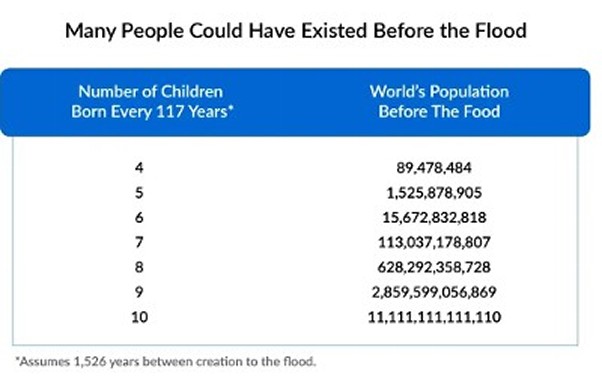

| Conclusion: How was the world populated? The answer is simply by Adam and Eve and their children. |



|
|
|

![]()

